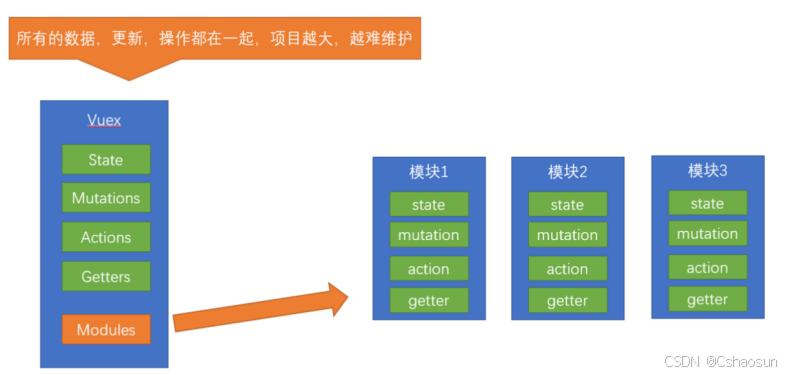简介
vuex 是 vue.js 应用的状态管理模式,它为应用内的所有组件提供集中式的状态(数据)管理。
可以帮我们管理 vue 通用的数据 (多组件共享的数据)。
vuex的构成
state:state 是 vuex 的数据中心,也就是说state是用来存储数据的。getters:state 对象读取方法。vue components 通过该方法读取全局 state 对象。mutations:状态改变操作方法。是 vuex 修改 state 的唯一推荐方法,其他修改方式在严格模式下将会报错。 该方法只能进行同步操作, 且方法名只能全局唯一。 操作之中会有一些 hook 暴露出来, 以进行state 的监控等。actions:操作行为处理模块。 负责处理 vue components 接收到的所有交互行为。 包含同步/异步操作, 支持多个同名方法, 按照注册的顺序依次触发。 向后台 api 请求的操作就在这个模块中进行, 包括触发其他 action 以及提交 mutation 的操作。 该模块提供了 promise的封装, 以支持 action 的链式触发。modules:将 store 分割成模块,每个模块拥有自己的 state、getters、mutations actions。

vuex的使用
1、安装 vuex:npm install vuex。
2、创建store示例
store对象
import vue from 'vue';
import vuex from 'vuex';
vue.use(vuex);
export default new vuex.store({
state: {
count: 0
},
mutations: {
increment(state) {
state.count++;
}
},
actions: {
increment({ commit }) {
commit('increment');
}
},
getters: {
count: state => state.count
}
});在 vue 根实例中注册store
import vue from 'vue';
import app from './app.vue';
import store from './store';
new vue({
store,
render: h => h(app)
}).$mount('#app');在组件中使用 store
export default {
computed: {
count() {
return this.$store.state.count;
}
},
methods: {
increment() {
this.$store.dispatch('increment');
}
}
};使用vuex内容扩展
在真正开发中使用vuex时会有好多细节知识和注意事项,下面我们扩展一下,仅供参看
vue 组件中获得 vuex 状态(state)
方式一: this.$store.state获取
通过在根实例中注册 store 选项,该 store 实例会注入到根组件下的所有子组件中,且子组件能通过 this.$store 访问到
computed: {
count () {
return this.$store.state.count
}
}方式二: mapstate 辅助函数获取(推荐)
当一个组件需要获取多个状态时候,将这些状态都声明为计算属性会有些重复和冗余。为了解决这个问题,我们可以使用 mapstate 辅助函数帮助我们生成计算属性
<template>
<div>{{count}}</div>
</template>
<script>
import { mapstate }from 'vuex
export default{
computed:{
...mapstate(['count'])
}
}
</script>getter的定义和获取方式
定义getters:
需要显示所有大于5的数据,正常的方式,是需要list在组件中进行再一步的处理,但是getters可以帮助我们实现它
【下面getters引用的state中的数据:list: [1, 2, 3, 4, 5, 6, 7, 8, 9, 10]】
getters: {
// getters函数的第一个参数是 state
// 必须要有返回值
filterlist: state => state.list.filter(item => item > 5)
}获取getters:
方式一: 通过属性访问
this.$store.getters.filterlist
方式二:辅助函数 - mapgetters
<template>
<div>{{filterlist}}</div>
</template>
<script>
import { mapgetters }from 'vuex
export default{
computed:{
...mapgetters(['filterlist'])
}
}
</script>vue组件中调用vuex:mutations中的方法
- 直接通过 store 调用 $store.commit('模块名/xxx ', 额外参数)
- 通过 mapmutations 映射
1、默认根级别的映射 mapmutations([ ‘xxx’ ])
2、子模块的映射 mapmutations(‘模块名’, [‘xxx’]) - 需要开启命名空间
方式一:普通调用方式
- this.$store.commit('addcount') 此为不带参数的写法
- this.$store.commit('addcount', 10) 此为带参数写法
<template>
<div @click="adddata">{{count}}</div>
</template>
<script>
export default{
methods: {
adddata() {
this.$store.commit('increment')
}
}
}
</script>方式二:辅助函数- mapmutations
mapmutations是将所有mutations里面的方法映射为实例methods里面的方法
<template>
<div @click="adddata">{{count}}</div>
<div @click="increment">{{count}}</div>
</template>
<script>
export default{
import { mapmutations } from 'vuex'
methods: {
// 有别名的写法[对应第一行div]
...mapmutations({
adddata:'increment'
})
// 同名的简写[对应第二行div]
...mapmutations(['increment'])
}
}
</script>vue组件获取vuex:actions中的方法
- 直接通过 store 调用 $store.dispatch('模块名/xxx ', 额外参数)
- 通过 mapactions 映射
1、默认根级别的映射 mapactions([ ‘xxx’ ])
2、子模块的映射 mapactions(‘模块名’, [‘xxx’]) - 需要开启命名空间
方式一:普通调用方式
this.$store.dispatch('increment')
this.$store.dispatch('increment',{num: 10})<template>
<div @click="adddata">{{count}}</div>
</template>
<script>
export default{
methods: {
adddata() {
this.$store.dispatch('increment')
}
}
}
</script>方式二:辅助函数 -mapactions
mapactions 是把位于 actions中的方法提取了出来,映射到组件methods中
<template>
<div @click="increment">{{count}}</div>
</template>
<script>
export default{
import { mapactions } from 'vuex'
methods: {
...mapactions (['increment'])
}
}
</script>总结
以上为个人经验,希望能给大家一个参考,也希望大家多多支持代码网。






发表评论